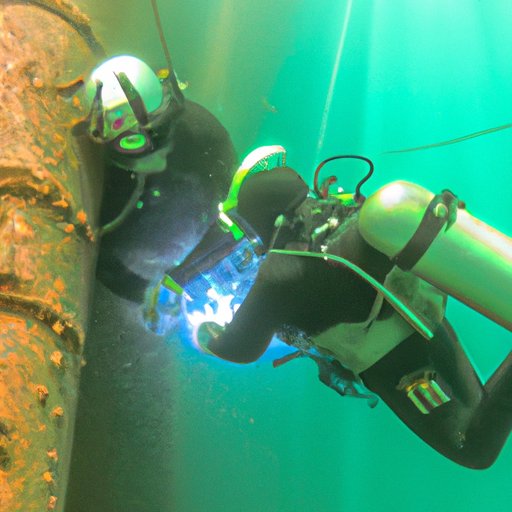Introduction
Underwater welding is a specialized form of welding that is used to join two metal pieces together while they are submerged in water. This type of welding is often used in the construction, repair, and maintenance of underwater structures such as ships, bridges, dams, and oil rigs. It is also used for the maintenance of pipes, valves, and other components of pipelines and underwater equipment.
Underwater welding presents a number of challenges due to the hostile environment in which it takes place. The welders must be properly trained and certified, and they must use special tools and techniques to ensure the welds are strong and reliable. Safety is of utmost importance when performing underwater welding, as the welders are exposed to extreme temperatures and pressures.
A Comprehensive Guide to Underwater Welding
Underwater welding requires special techniques and tools that are not used in traditional welding. The welders must be familiar with the different types of welding rods, fluxes, and electrodes that are available for underwater welding. They must also be aware of the specific safety precautions that must be taken when working in an underwater environment.
The most commonly used tools for underwater welding include welding torches, underwater cutting tools, and electrodes. The welding torches are designed to provide the necessary heat to melt the metal pieces together. Underwater cutting tools are used to cut the metal pieces before they are welded together, while electrodes are used to create the electrical arc that is necessary for the welding process.
When performing underwater welding, safety is of utmost importance. The welders must wear protective clothing, including a face mask and gloves, to protect them from the high temperatures and pressure of the underwater environment. They must also be aware of the potential hazards of electric shock and poisonous gases that can be released during the welding process.
Becoming an Underwater Welder
To become an underwater welder, individuals must first complete a comprehensive training program. This typically includes both classroom instruction and hands-on practice in a controlled environment. During the training program, welders will learn about the different tools, techniques, and safety protocols associated with underwater welding.
Once the training program has been completed, welders must pass a certification exam to demonstrate their knowledge and skills. After passing the certification exam, welders can then apply for jobs in the field of underwater welding. Most employers require welders to have at least two years of experience before they can be hired.

The Science Behind Underwater Welding
Underwater welding involves a complex set of mechanics that must be understood in order to perform the job successfully. The welders must be familiar with the different welding rods, fluxes, and electrodes that are available for underwater welding. They must also understand the proper techniques for creating a strong and reliable weld.
There are several types of welds used in underwater welding, including shielded metal arc welding (SMAW), gas tungsten arc welding (GTAW), and flux cored arc welding (FCAW). Each of these welding processes requires a different set of tools and techniques to be used correctly. It is important for welders to understand the differences between each type of weld in order to choose the best option for their project.

What to Expect from an Underwater Welding Job
Underwater welding is a challenging but rewarding career. Welders who are successful in this field can expect to enjoy a variety of benefits, including competitive salaries and the opportunity to work in some of the world’s most interesting locations. On the other hand, there are also risks associated with the job, including the potential for electric shock and poisonous gas exposure.
Welders should also be prepared to work in extreme conditions, as the temperatures and pressures in an underwater environment can be hazardous. Additionally, welders must be comfortable with the idea of spending long periods of time away from home, as many underwater welding projects can take weeks or even months to complete.
Conclusion
Underwater welding is a specialized form of welding that is used to join two metal pieces together while they are submerged in water. The welders must be properly trained and certified, and they must use special tools and techniques to ensure the welds are strong and reliable. Becoming an underwater welder requires completing a comprehensive training program and passing a certification exam.
Underwater welding involves a complex set of mechanics that must be understood in order to perform the job successfully. There are a number of benefits to a career in underwater welding, including competitive salaries and the opportunity to work in some of the world’s most interesting locations. However, there are also risks associated with the job, including the potential for electric shock and poisonous gas exposure.
Underwater welding is a challenging but rewarding career. Those who are interested in becoming an underwater welder must be prepared to work hard and learn the necessary skills and safety protocols. With the right training and dedication, welders can enjoy the many benefits of a career in underwater welding.
(Note: Is this article not meeting your expectations? Do you have knowledge or insights to share? Unlock new opportunities and expand your reach by joining our authors team. Click Registration to join us and share your expertise with our readers.)
